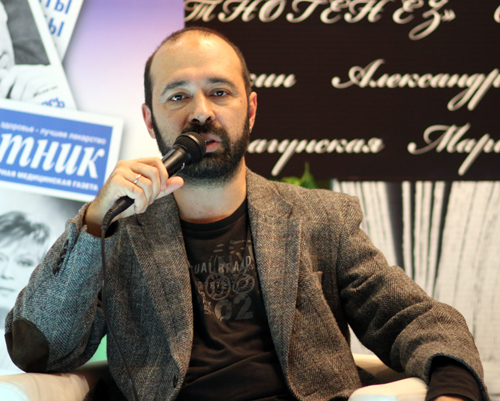
Sergey Kuznetsov is a serious man. A seriously talented man, yes, but serious nonetheless. Butterfly Skin, Kuznetsov’s most recent novel, is a serial killer tale set in modern-day Moscow. Although at times graphically violent and even more graphically sexual, Kuznetsov wants to assure his readers that Butterfly Skin is about love. Well, love and violence, which go hand-in-hand like sex and death (more on that later).
A word of caution: this interview did not occur as a face-to-face meeting. As much as I would’ve liked to have met Mr. Kuznetsov and pained him with my novice Russian spoken in the dialect of Boris Badenov, we were forced to communicate via the internet. Specifically, I wrote the questions and he answered them with the help of the fine folks over at Titan Books. Accordingly, don’t expect this interview to present more than Q&A. Neither of us could get a “read” on the other, although I expect Mr. Kuznetsov was less than thrilled with my line of questioning. Then again, maybe Mr. Kuznetsov just doesn’t want to be entertained, especially by some hack from America. Mr. Kuznetsov does not want laughter either, so keep your snickers to yourself.
Another brief word: before reading this interview, give yourself a refresher on the topic by reading our review of Butterfly Skin here.
RavMon: In Butterfly Skin, life in modern Russia, specifically Moscow, is a major focus. What are your personal thoughts on the current state of affairs in Russia? Do you think social politics have a hand in contributing to serial murder and/or mass killing? If so, how?
Sergey Kuznetsov: In fact, Butterfly Skin was written more than ten years ago, so it is not about “the current state of affairs in Russia.” However, the violence of twentieth century Russian history influences contemporary Russian society, so the current crisis in the southwest Ukraine is not only the result of Putin’s irresponsible and dangerous politics, but also the bloody history of the last century. I recently wrote about this in an op-ed piece in The New York Times. Regarding the issue of serial murders, I suppose one of the possible reasons is there are some skeletons in the closet, as the British say. This may derive from America’s old Puritan notion of the sinfulness of sex or the Russian hidden memory about the victims of terror. However, deep down I believe we don’t fully know the sources of the violent phantasms that people like the main character of my book are obsessed by. What we do know is that evil exists; pain and violence are deeply engrained in the human soul. At times they are resurrected and it’s better to be in another place and time when this happens.
RavMon: Did you have to research Ksenia’s sexual proclivities? If so, what were some of the more startling things that you found?
SK: I didn’t do special research. I have a few friends in the BDSM circles of San Francisco and Moscow, and I spent a lot of time talking with them about their sexual tastes and practices. Of course, I don’t want to say that every masochistic woman has the same pain in her soul as my Ksenia has. Some people just like extreme stimulation or like to play with control, so sometimes BDSM is not associated with the violence metaphysic I was interested in exploring when I wrote the novel.
The majority of people, including some BDSM people, are not interested in violence at all – I suppose the main character of Fifty Shades of Grey is one of them – but I wanted to write a novel about people who have a strong inner relationship with violence, because I am interested in violence myself. I found two poles on the scale – an immoral sadistic killer and a good-willed masochistic girl. The tension between them creates a kind of nervous nexus in my novel.
Talking about startling aspects of BDSM practices… if you don’t know them, you just don’t need to know. The majority of people don’t like to hear about things like this; for all others, there is Google.
RavMon: What’s the relationship between sex and death? In America, it’s sort of a joke, but what are your thoughts on the closeness between the two extremes?
SK: I live in Paris and the relationship between sex and death is commonplace in French culture. I think it’s a joke in the US because of the Puritan roots of your country. Finally, sex is about losing yourself (just as in mystical or some drug experiences) and, of course, death is the ultimate form of loss. I don’t mean every time we have sex we feel a kind of loss of ourselves or a death-like experience, but the best sexual experiences are about it. Otherwise why the hell would we do it? Just for pleasure? I don’t believe that!
RavMon: Butterfly Skin is full of references to real serial killers. How much of this was researched and how much of it came from your own interests? Can researching the history of serial killers tell us something about a time period or are they too individualized to say anything of real importance about a society?
SK: I did some research, yes. I’m interested in violence, as I wrote above, so it came out of that. However, one of the most disgusting things I know is a kind of glamorization of serial killers. They are poor, sick creatures, not some Hannibal Lecter-style super-humans, as some serial killer fans imagine. As I said before, I don’t know the reasons why people become serial killers. Post-Traumatic Stress Disorder is one good hypothesis, although I don’t know any time period in the past without trauma. Let’s look at America: WWII, Vietnam, the Gulf War, 9/11. Every ten years you have some traumatic experience! And you haven’t had a war in your continental territory for at least the last hundred years! Of course, it’s much worse in Europe. It seems that we humans do not have a good era, just different shades of bad, so any time period may give birth to monsters.
RavMon: As someone with a background in journalism, what do you think the relationship between journalism and fiction writing is? Why do so many writers find journalist protagonists so attractive?
SK: There is no relationship. The secret is very simple: there are people who like to write. I wrote fiction till my school years, but it was really bad, so it was easier to write articles and reviews. However, I worked hard and my fourth or fifth novel was good enough to show to publishers.
The main character of Butterfly Skin is a journalist because I needed someone who could trace the killer, but not a cop. And, of course, I’m familiar with her job. It’s easier to write about a female character if you can share some experience with her. By the way, I wrote seven novels, and, as far as I remember, Ksenia is the only journalist I wrote about.
RavMon: How hard was it to write a novel like Butterfly Skin, where so much of the “action” takes place within the minds of your characters?
SK: It was hard to write Butterfly Skin because I’m not the serial killer. To live in his skin is a very unpleasant experience. Honestly, after the novel I couldn’t read any serial killer novel at all. I began to identify not with the victim, but with the killer, and to be inside a killer’s mind is really hard and scary. My advice: don’t try this at home.
RavMon: One of the things that I enjoyed so much about Butterfly Skin was that it was written in a lot of different voices. From internet forum speak to poetry, Butterfly Skin does a wonderful job of presenting these crimes from several vantage points. What inspired you to write like this? Do you think that this style is the only one that makes sense in our information-heavy age?
SK: I wrote my previous novel, PG-21, with my friend Linor Goralik. She is a poet, so I had some experience in writing prose as poetry. Another reason is that it’s really boring to write from only one character’s viewpoint.
I don’t really think it has to do with our information-heavy age. As I remember the English writer Wilkie Collins (1824-1889) wrote his novels (The Moonstone, The Woman in White) from several vantage points. So, it’s a kind of tradition for mystery novels.
RavMon: Ravenous Monster is a webzine dedicated to horror culture. Do you think Butterfly Skin is a horror novel?
SK: I do not think it’s a writer’s job to classify his work. Some of my books were awarded prizes in Russia such as the Best Horror Novel of the Year, but for me Butterfly Skin is a love story first of all. A story about love and violence.
RavMon: Certain parts of Butterfly Skin are hard to read because of the frankness in terms of the sex and violence. Do you think that these topics are better served through blunt discussion, or is there a justifiable argument against talking about these things so explicitly?
SK: I don’t like torture porn; at least torture porn that pretends to be art or literature. I used some kind of verse when I wrote about the most brutal violence – just as Quentin Tarantino uses black and white in his Kill Bill, Vol.1 to make the violence not so naturalistic. As any writer, I’m convinced we have to talk about everything worrying us, including any form of sex, violence, or I don’t even know what else. If someone is obsessed by violence, it’s better to write or to read about it than practice it in so-called real life.
RavMon: Thank you so much for your time. Is there anything you’d like to say to our readers and your fans in the U.S.?
SK: I would like to recommend that you don’t read the novel as “a very Russian tale.” Of course, I wrote about Russia – I know the country much better than any other one and I lived there most of my life. However, I recommend that American readers imagine it as a story that could take place in their own town, especially since the US breaks the record when we talk about the number of serial killers. I really love the US and if I had an extra life I would like to write Butterfly Skin about San Francisco or New York. Try to imagine it’s your own story, and if you feel horror and excitement, I will be happy.
I would like to add one important thought. Our culture, our religion, any basic aspects of the world we live in – it all deals with violence. Greek mythology, the Old Testament/Torah or the New Testament/Gospels – everywhere we find tales of violence. We witness this violence in any big museum: the snakes suffocate Laocoon and his sons; King Herod orders all babies in Judea killed; Jesus dies after torture on the Cross. Of course, sculptures and paintings are great to look at, but they also remind us how important violence is in art. The most important works of art are not about fun. They are disturbing, uneasy, and scary and I try to write uneasy and scary as well.
When we go to the theater for a new action blockbuster, we are ready to see explosions, blood, and even dead bodies; however, we are sure to be entertained. But the Massacre of the Innocents is not funny. The Death on the Cross is not funny. The story about Niobe’s children killed by Apollo and Artemis is not about fun either. I hope my novel is not funny. It has to be disturbing, uneasy, and scary. This is the only fair way to talk about violence.















